
 |
|
I came up with the K-21 kind of as a by-product of designing the K-19. I didn't set out to design a plane of this sort, but when working on the details of the angles and positions of the folds in the K-19 I noticed that stopping partway and just folding the nose in flat gives a very advanced-looking aircraft. I wasn't very optimistic about how well it would fly, but went ahead and tried it out and found it works better than expected.
Underlying the Dragonfly's somewhat complex appearance is a very simple structure with fewer folds than just about any other paper airplane. It can be tricky to make though if you're just learning the kind of fold it uses. It's easier than the Sharky even though this fold is similar, because the folds don't need to be positioned as precisely.
 The fact that there isn't much structural constraint on the angles and positions of the main folds
in the K-21 allows you to vary them to get a range of actual airplanes. And it's an interesting
design to experiment with flight-tuning using fins and flaps, because of the extra control
surfaces of the front canard wings.
The fact that there isn't much structural constraint on the angles and positions of the main folds
in the K-21 allows you to vary them to get a range of actual airplanes. And it's an interesting
design to experiment with flight-tuning using fins and flaps, because of the extra control
surfaces of the front canard wings.
Over the years I've never had good results with planes of this sort of flat, short shape, large proportion of wing versus fuselage area, and flat nose. Duration of flight winners are often that general shape though.
I'm not quite sure what performance and handling characteristics are most typical of good duration designs.
I like to think of the K-21 as a Stingray because of its flatness and how it kind of slides through the air. I've decided on calling it the Dragonfly instead because it makes it easy to describe the configuration of the 4 wings.
So far the flight characteristics aren't a complete thrill but not a
total disappointment either. The main problem is that it tends to stall
easily, which might be solved with some flaps or fins, or if the weight
could be somehow concentrated farther forward. On the positive side, it does well
at staying right side up and not rolling over in flight. Also the drag seems quite low
despite the complexity of the shape.
| Images, Text, and 3-D Forms Depicted © 2001 PaperAirplanes.net |